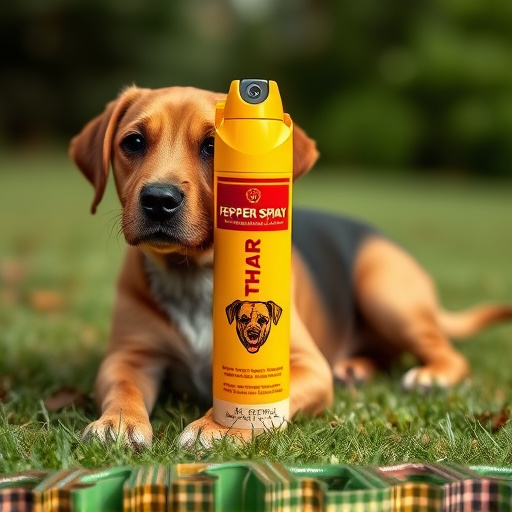Dog deterrent sprays use natural compounds to prevent aggression without permanent harm. Choose reputable brands, follow instructions, and flush eyes with water for 15 minutes in case of accidental eye exposure. Pepper spray causes severe reactions in dogs; quick action is crucial for removal and veterinary care if symptoms persist. Target face and paws, avoid spraying eyes, and clean faces post-outdoor activities to prevent irritation. Understand legal frameworks and regional regulations regarding dog deterrents, emphasizing safe handling and responsible usage.
“Mace brand dog deterrent spray is a popular tool for pet owners aiming to protect their properties from unwanted canine visitors. This comprehensive guide delves into the world of dog deterrents, exploring critical aspects such as ingredients and safety, the impact of pepper spray on dogs, and legal considerations. We provide practical tips for effective application and safe removal techniques, including how to quickly and gently remove pepper spray from a dog’s sensitive eyes. By understanding these key elements, responsible pet owners can safeguard their spaces while ensuring their four-legged friends remain unharmed.”
- Understanding Dog Deterrent Sprays: Ingredients and Safety
- How Pepper Spray Affects Dogs: Symptoms and Removal Techniques
- Effective Application: Ensuring Maximum Deterrence Without Harm
- Legal Considerations and Responsible Use of Dog Deterrents
Understanding Dog Deterrent Sprays: Ingredients and Safety
Dog deterrent sprays are designed to protect both pets and their owners from unwanted canine behavior, such as aggression or territorial marking. Understanding the ingredients in these products is crucial for ensuring safety. Common components include capsaicin, a natural compound found in chili peppers, which irritates the dog’s nostrils and eyes, deterring them without causing permanent harm. Other ingredients like citronella and peppermint oil are often added for their scent properties, further enhancing the deterrent effect.
When it comes to safety, especially around pets’ sensitive areas like the eyes, it’s important to note that some sprays may cause irritation or even temporary blindness if they come into direct contact. Therefore, choosing a reputable brand and following application instructions carefully is essential. If your dog accidentally gets pepper spray in their eyes, immediate action should be taken—flush the eyes thoroughly with water for at least 15 minutes and seek veterinary care if irritation persists.
How Pepper Spray Affects Dogs: Symptoms and Removal Techniques
Pepper spray, a common self-defense tool for humans, can have severe and immediate effects on dogs if used in their proximity. Dogs, with their sensitive respiratory systems and eyes, are particularly vulnerable to the active ingredients in pepper spray, which typically include capsaicin, a compound found in chili peppers. When a dog is exposed to pepper spray, it can experience a range of symptoms, including tearing, itching, stinging, and even temporary blindness due to irritation in their eyes and respiratory tract.
If your dog comes into contact with pepper spray, quick action is essential. Remove any visible remnants of the spray from their fur using a damp cloth or water. For eyes, rinse gently but thoroughly with plenty of water for at least 15 minutes. If the spray has entered the dog’s eyes, avoid rubbing as it may worsen irritation. Seek veterinary assistance if symptoms persist or if your dog shows signs of distress, difficulty breathing, or severe eye inflammation. Remember, prevention is key; keep pepper spray out of reach from pets and consider alternative deterrent methods for animal safety.
Effective Application: Ensuring Maximum Deterrence Without Harm
For maximum effectiveness, proper application of a dog deterrent spray like Mace Brand is key. It’s crucial to target specific areas, such as the dog’s face and paws, where they have sensitive scent receptors. Spritzing too high or in open spaces can reduce the concentration and thus, its deterrence power. Always follow the product instructions for application technique and frequency to ensure success without causing harm.
One common concern with pepper spray is its potential impact on a dog’s eyes. If sprayed directly into their eyes, it can cause significant irritation and temporary blindness. Therefore, during application, avoid aiming towards their faces. Instead, focus on areas where they’re more likely to encounter the scent first, like entry points or potential trouble zones. Additionally, regular cleaning of your dog’s face with a mild, tear-free solution after outdoor activities can help remove any residual pepper spray, preventing possible eye irritation.
Legal Considerations and Responsible Use of Dog Deterrents
When considering any dog deterrent methods, including spray, it’s crucial to understand the legal framework surrounding their use. Different regions have distinct regulations regarding the types and applications of deterrents, especially those aimed at animals. Pepper spray for dogs, or any irritant-based deterrent, must be used responsibly and in adherence to local laws to avoid penalties.
Responsible usage involves ensuring the safety and well-being of both pets and individuals. For instance, removing pepper spray from a dog’s eyes is a critical consideration. It should only be applied under controlled conditions, avoiding sensitive areas like the eyes, nose, or mouth. Pet owners must receive proper training on handling such deterrents to prevent accidental harm and ensure their effectiveness in scaring off intruders or aggressive dogs without causing undue distress.
Dog deterrent sprays, like mace brand products, offer a non-lethal way to protect against aggressive canine behavior. By understanding the active ingredients and safety measures, responsibly applying them, and being aware of legal considerations, pet owners can effectively deter unwanted dog interactions while minimizing harm. For any accidental pepper spray contact, immediately removing it from the dog’s eyes is crucial. Always consult with a veterinarian or local animal control for guidance on proper usage and post-application care to ensure your pet’s well-being.
